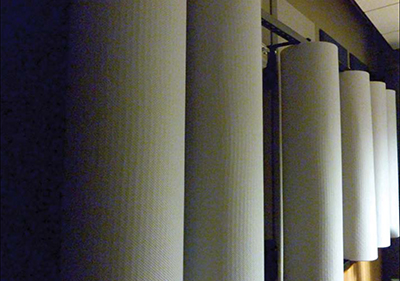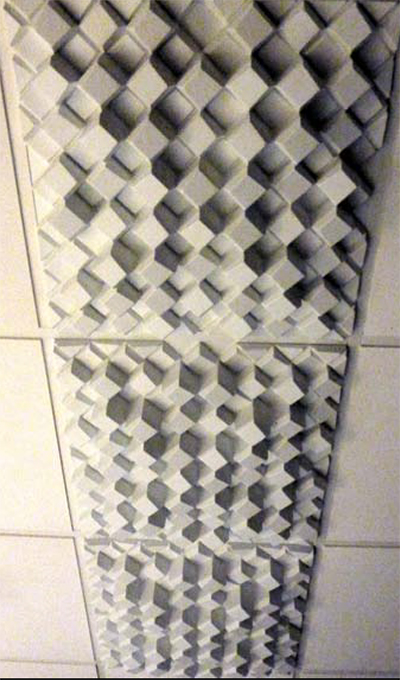Exploring Audio Control Room Acoustics-Part I
When you think of audio control rooms you most likely recall a glossy magazine cover shot of a gigantic room inhabited by a large mixing desk with odd-looking geometric shapes and acoustic treatment of the walls. Some of those same people would probably be surprised to discover that, in television at least, this type of room is the exception rather than the norm.
Shrinking budgets and the desire to create content for new markets means that audio control room budgets continue to decrease and they’re being forced into ever- smaller and less functional spaces.
The point of building an audio mix room in the first place is to give the audio mix engineer the ability to hear everything with clarity and accuracy and to do so without inconveniencing the rest of the crew. Video editors and graphic artists won’t easily give up color-matched monitors and light-controlled, low-glare workspaces, yet audio mixers are rarely offered quiet, acoustically-true workspaces to work in.
Part of the problem is that nonlinear editing software and video production tools have dropped in price dramatically as have the machines they run on and the monitors they use for display. Meanwhile the cost of audio consoles has remained high, space is difficult to obtain, and construction costs are always increasing, all of which means that audio production rooms now often cost more than video production rooms.
In a business that rarely considers audio anything other than a nuisance, this is a dangerous position to be in. Of course there are solid scientific reasons for traditional audio control room design, so let’s look at the benefits of large control rooms and what we can do to minimize the inherent shortcomings of small control rooms.
LARGER CONTROL ROOMS SOUND BETTER
One fact that is rarely mentioned when space is parceled out for audio control rooms is that low-frequency waveforms are enormous and they cause enormous problems in small rooms. If we generate a 20 Hz sine wave and play it through speakers capable of reproducing it, the resulting waveform will be 56.5 feet long (68 degree air at 1,130 feet per second), though most people will feel this frequency rather than hear it.
If instead we generate an easily heard 60 Hz sine wave, the resulting wavelength is 18.84 feet long. Low frequencies are omnidirectional, so they’re essentially emanating from the speakers in all directions, which means we end up with some fairly large waveforms heading for the walls, ceiling and floor.
As these waveforms are made up of energy, the room needs to be large enough to accommodate them or this energy will build up and create standing waves (resonant modes). Waveforms created by mixing sounds together are much more complex than simple sine waves, so most small rooms contain multiple problematic modes. Often these modes result in low-frequency build-up in the corners and rear of the control room where the client sits.

Side absorbers It’s worth noting that even large rooms have modes, but because there is more space (volume) the modes will be more evenly distributed. Smaller rooms mean less space, so the modes are far more likely to either interact or separate, which will cause the frequency response to vary at different locations throughout the room. Small, cube-shaped rooms have the most mode problems of all and should be avoided at all costs.
The best help for standing waves is to make the room larger, but since this is usually not an option such spaces will need to be treated by using a spectrum analyzer to locate frequency build-up where it occurs in the room and then by careful placement of absorbers and bass traps to minimize the problem modes as much as possible.
LARGE ROOMS MINIMIZE REFLECTIONS
When we sit at the mix position we anticipate that all sound will emanate directly from the speakers even though some of it will be indirect sound reflected from a surface in the room. Hard surfaces of all types cause reflections, including the mixing desk, walls, floors, ceilings and video monitors.
Reflections are actually normal and help us determine room dimensions as we listen, but when these reflections arrive at the mix position at a decibel level similar to that of the mix they begin to interfere with our ability to accurately discern the sound coming from the speakers.
All sounds arriving within the first 50 ms are interpreted by our brains as if they originated from the same sound source (Haas effect). So if there are lots of early reflections in the soundfield it is unlikely we will hear them or have any idea that the room has become part of the mix.

Diffusors in the ceiling Larger rooms minimize reflections from walls and ceilings because the distance from the speakers and the mix position is greater. In smaller rooms those surfaces are much closer. Reflections from them must be factored in and dealt with. Large rooms also give midrange and high frequencies more time to abate in air, yet those same frequencies are likely to encounter a wall or some other surface in a small room before they have the chance to dissipate, so they become audible reflections.
Whether a reflection is early, late or somewhere in between, it is advantageous to minimize it to the point that it does not interfere with the mix engineer’s ability to accurately hear at the mix position. This can be done by moving or removing the reflective surfaces, placing absorption where the reflections occur or adding a diffusor to scatter them and minimize their impact. Usually a combination of the three provides the best solution and care must be taken to avoid adding so much absorption that the room becomes lifeless and fatiguing to mix in.
We’ve looked at only a couple of aspects of control room acoustic issues in this column and just at a very high level. The science of acoustics is much deeper, even on these two aspects, than we have the space to delve into here. If you find yourself in need of help with room acoustic issues, hiring a professional acoustic consultant will be money well spent.
Next time we’ll look at isolation, room shapes, some practical applications and continue assessing how to do the best work we can in small control room spaces.
Jay Yeary is not an acoustician, but is fortunate enough to know and work alongside people who have considerable talent when it comes to audio room acoustics. He can be reached through TV Technology or via Twitter at @TVTechJay.
Get the TV Tech Newsletter
The professional video industry's #1 source for news, trends and product and tech information. Sign up below.
